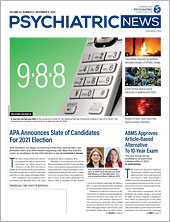APA Trustees approved the inclusion of prolonged grief disorder in DSM, subject to approval by the Assembly, at its virtual October meeting. The recommendation for the inclusion came from the DSM Steering Committee after a two-year process of review by the committee and relevant APA components and taking into account public comments.
“There is substantial evidence that the proposed category would meet criteria for a mental disorder, have strong evidence of validity, and be capable of being applied reliably,” said Kenneth Kendler, M.D., vice chair of the DSM Steering Committee. “We believe it will have substantial clinical value, identifying a group of patients now not receiving appropriate clinical attention and facilitate the appropriate use of available treatments.”
Items are usually approved by the Assembly before being considered by the Board, but the new diagnosis was brought to the Board to meet the deadline for inclusion in DSM-5-TR, which is reaching the final stages of production. A full list of the criteria for the disorder appears in the box below.
Kendler told the Board that studies dating back several decades suggest that many people experience persistent difficulties associated with bereavement that are substantially prolonged beyond “culturally normed expectations.” Data suggest that symptoms of prolonged bereavement are different from those associated with major depression, he said.
Moreover, specific treatment approaches have been developed and tested for sustained symptoms of bereavement.
DSM-5 included a category of persistent complex bereavement disorder (PCBD) as a “Condition for Further Study” in Section III of the manual. In 2018 a proposal was submitted to include the category in the main text of the manual, which underwent review by the DSM Steering Committee and the Review Committee on Internalizing Disorders. In June 2019 a workshop was held in New York City to develop consensus around appropriate criteria for the diagnosis.
Criteria were finalized later in 2019 and approved by the DSM Steering Committee this past January. They were posted for public comment in the spring and approved by the steering committee in August.
The Board also approved a number of action items brought by the Presidential Task Force on Structural Racism Throughout Psychiatry to increase participation of Black members in APA governance. By approval of the Board, a list of Black APA/APAF Fellows will be reported to the district branches, which will be instructed to reach out to them and encourage their participation and leadership as well as consider them for APA Assembly representative positions.
As recommended by the task force, the Board also directed the Assembly Executive Committee to take the following actions to increase participation of Black members in the Assembly. Among them:
•
Establish a mentor/sponsor program for Black psychiatrists drawing on senior Assembly leaders as mentors.
•
Adopt consistent term limits for all Assembly Area representatives and Assembly Area deputy representatives.
•
Instruct the Assembly Nominating Committee about the importance of nominating a diverse pool of nominees.
•
Include the minority/underrepresented (M/UR) caucuses and the M/UR Committee of the Assembly in the Assembly nomination process by having them submit nominations directly to the Assembly Nominating Committee.
•
Identify “Equity Advisors” to advise the Assembly on all aspects related to diversity and equity.
In comments to Psychiatric News after the meeting, task force Chair Cheryl Wills, M.D., said she believes the task force has made promising progress since its inception in June.
“The work groups have been using data including recent membership surveys to inform how they proceed,” she said. “If the data suggest an absence of member diversity in a particular area, such as the APA Assembly, then the relevant work group strives to identify potential reasons for the deficit and suggests actionable items that may remedy the problem. Each work group’s analysis is presented to the task force for further discussion and refinement before the final draft is presented to the Board of Trustees. Work groups are also looking at diversity within the APA governance and the councils and committees.”
She also said the task force wants to examine the Annual Meeting Scientific Program to help ensure a diverse range of speakers and sessions that address cultural psychiatry, diversity, and structural racism.
Wills added that she believes the benefits of the task force recommendations will extend beyond Black psychiatrists to psychiatrists of other M/UR groups.
Trustees also heard a report from past APA President Anita Everett, M.D., who is chair of the APA Presidential Task Force on Assessment of Psychiatric Bed Needs in the United States (see
Psychiatric News here and
here).
Everett said the task force is on track to produce the first iteration of a model for determining how many psychiatric beds a community needs before or shortly after the new year. In past interviews with Psychiatric News, Everett explained that the model is likely to be rudimentary but can be refined over time to incorporate more variables impacting community need. The kinds of variables that might mitigate the need for inpatient beds include the presence of crisis intervention teams, day treatment programs and Assertive Community Treatment teams.
“Working under a very ambitious timeline, we are hoping to have a model that can inform the nation about a holy grail of public psychiatry,” Everett told the Board. “How much inpatient service does a community need versus outpatient service, and what kind of services mitigate the need for inpatient care?” ■
Information about the Presidential Task Force to Address Structural Racism Throughout Psychiatry is posted
here.
APA members interested in learning about the Presidential Task Force on Psychiatric Beds in the United States or contributing their time or expertise to it are urged to contact Laura Thompson in the APA Division of Research at
[email protected].
